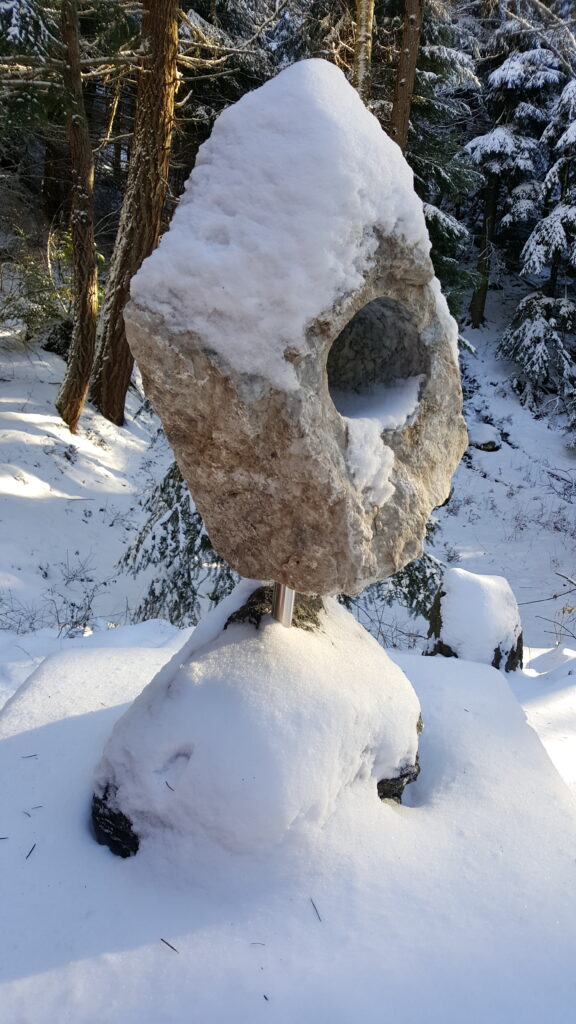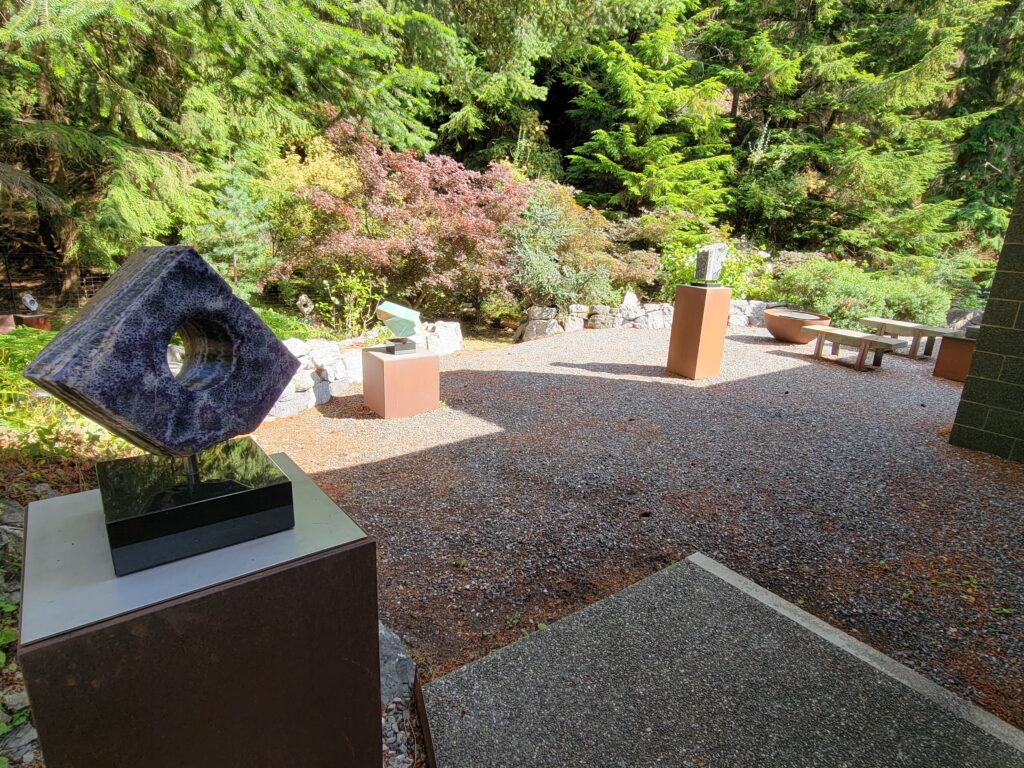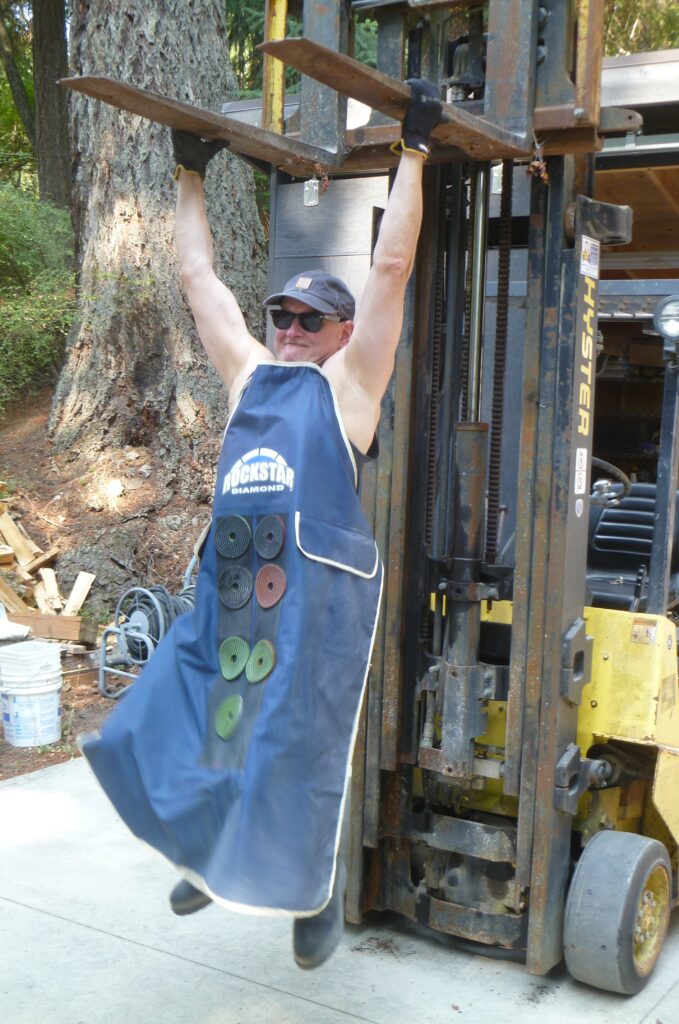
Background

I am a man of my time…
Deep Time, that is.
Deep time is a term often used to describe the vast amount of time that has passed since the first stones of Earth were formed, roughly 4.5 billion years ago. If you can think geologically in Deep Time, you can get a perspective on the age and processes of the rocks you sculpt.
Time and stone have been keen interests of mine since my college days at Stanford. There I obtained two degrees in geologic sciences and became aware that my interest in these subjects was more than merely scientific. Although my early career focused on the Earth Sciences, by the 1990s, I began to appreciate the beautiful aesthetics of sculpted stone at various galleries and museums located throughout the footprint of my global energy career. I started sculpting after I moved to Orcas Island and attended my first stone class in 2005; a hand carving workshop on San Juan Island. I learned to sculpt from attending NWSSA events and being lucky enough to be mentored by some of our most skilled sculptors. I gradually developed an understanding of how the science and art of stone can be combined to produce solid, three-dimensional art objects I liked. As I began my “artistic” journey, my love of science remained. Understanding and explaining the geology of stone is still a passion of mine (well-known in the NWSSA world, see my Geology of Sculpting Stone Series referenced below.)
I have also always enjoyed a good story. My favorite pieces are hundreds of millions of years old and all have fascinating geologic creation stories. These stories are reflected in my finished sculptures’ appearance, whether it is in multicolored igneous mineral refractions or in the traces of ancient life in fossiliferous sedimentary rock.
Inspiration
My inspirations for stone sculpting:
Barbara Hepworth once said: “Working in the abstract way seems to release one’s personality and sharpen the perceptions so that in the observation of humanity or landscape it is the wholeness of inner intention which moves one so profoundly.”



Sculpting Style and Sculpture Creation
I enjoy direct carving stone from ideas in my imagination. The stone’s geologic characteristics will often determine how my imagined design will come into being. I adapt my design as I come to understand what this particular stone can offer. I think that both polishing certain areas and leaving behind sections of stone rind, can create a beautiful balance between revealing the inner nature of the rock while preserving its original weathered surface. If I find the stone contains an extraction mark (e.g. a core hole remnant) I will try to incorporate it into my design. More often than not, I sculpt hard igneous and metamorphic stone, which usually has the most interesting crystalline qualities. I find much of my exotic stone at the Tucson Gem and Mineral Show; the world’s largest stone event, held every year in January to March (See my article “the Biggest Show on Earth” below). My favorite tools are my angle grinders with flush mount diamond blades and my trusty Alpha air-water polisher.
I have completed about 100 works since 2005 and sold about two-thirds of them. Almost all are sold at the only sales event I participate in each year, the 3-day Orcas Artist Studio Tour. My other works, I have selected for my own home and outdoor sculpture garden.
I believe that almost everyone should have outdoor sculpture, if they have any personal outdoor space at all. My personal style has evolved from cubist architectural styled pieces and conceptual designs to minimal geometric abstract forms. I believe these simple forms work well with geologically complex stone to produce my most compelling sculptures. I often incorporate a reference to Platonic Solids (philosophical building blocks of reality according to the ancient Greeks) in the names of my pieces. I think that these “fragments” of geometric perfection create pleasure when we view them.
Constantin Brancusi once said “Simplicity is Complexity Resolved”

My Studio
My studio has evolved as I have progressed in my sculpting abilities. In 2009 I built a dedicated sculpting spot complete with a 1000 square foot concrete pad and storage building for my air compressor and tools. I erected a large awning over the concrete pad initially, however I removed it 5 years later as I found that I enjoyed unfiltered natural light for sculpting. Over time, I came to realize that I really didn’t like sculpting outside in weather below 50 degrees, so I have become a mostly seasonal sculptor between about April to October.

Our Family Monument
I have always been attracted to sculpture and sites that are meant to convey a purpose beyond the ephemeral; to signify a deeper, longer-term meaning. Our family monument and surrounding elements was designed in California Academy black granite with this in mind. This site was created as a place to reflect on our present lives and the next. One side of this work echoes Brancusi’s Endless Column, the others, symbolic moments in our families’ lives.
My Future in Stone Sculpture
After an early life of exploration science and business, my time with stone sculpture over the past 15 years has opened an artistic world to me. I was fortunate to find the NWSSA and its remarkable people to support me on this journey. I will continue my exploration of stone and form. I don’t know where this artistic journey will take me.
The trip has been great so far.
Isamu Noguchi once said: “Each sculpture is a miracle of chance. The shape, the size, the color, the blemish, its correction. And time, which completes all things, brings the sun into its alignment, when stone becomes mirror.”


My NWSSA Offices:
2013 to 2014 NWSSA Vice President
2015 to 2019 NWSSA Treasurer
2023 to Present NWSSA Treasurer
All below materials are available at NWSSA.org CarveStone.org
My Designed and Executed Workshops:
2014 Abstract on Orcas: An Overview of Abstract Stone Sculpture: 1,500,000 BC to Present, 3-day workshop on Orcas Island including NWSSA stand-alone presentation
2018 Herbert GeorgeSeminar: The Elements of Sculpting Stone; 3-day workshop, San Juan Islands, including The Elements of Sculpture: From the Physical to the Most Ephemeral, A Viewer’s Guide by Herbert George with some additional observations by NWSSA guests and members, A brief synopsis.
My Articles in Sculpture Northwest Magazine
2013 “Romancing the Marble of Portugal”
2013 “Experiencing the Finale Encore Staircase”
2014 “The Biggest Show on Earth”
2016 “Iceland is Hot!”
2017 “The Disappearing American Rock Shop”
The Geology of Sculpting Stone Series
2009 PNW Granite
2010 Indiana Limestone
2011 Columbia Basalt
2015 British Columbia Jade
2016 North Cascades Dunite
2022 Montana Quartzite










We need some kind of descriptive text here.